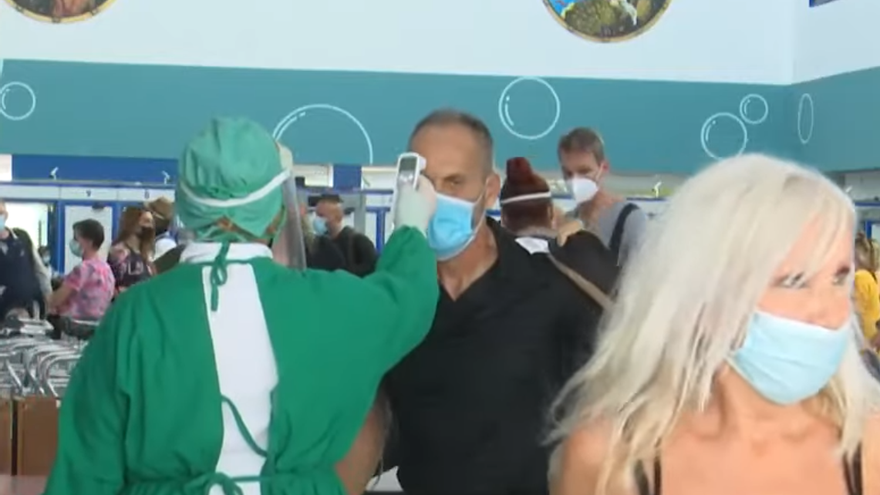
![]() 14ymedio, Madrid, 17 March 2021 — The collapse of tourism in Cuba as a result of the pandemic has colossal magnitudes. The arrival of travelers to the island has fallen by 95.5% in the first two months of 2021 compared to the same period of the previous year, according to the academic and university professor José Luis Perelló told the Chinese state agency Xinhua .
14ymedio, Madrid, 17 March 2021 — The collapse of tourism in Cuba as a result of the pandemic has colossal magnitudes. The arrival of travelers to the island has fallen by 95.5% in the first two months of 2021 compared to the same period of the previous year, according to the academic and university professor José Luis Perelló told the Chinese state agency Xinhua .
“During the first two months of 2021, some 35,600 international travelers arrived on the island, representing 4.5% of the 792,507 foreign visitors for the same period as of the end of February 2020,” he said.
Although a plummet in the numbers for this key sector for the national economy was expected, as in the rest of the world, the figure far exceeds the world average, set this January by the United Nations World Tourism Organization (UNWTO) at a drop of 74%. According to these data, in Europe, despite the activity in the sector over the summer, it touched figures that exceeded 70%. Asia, due to strict border closures, reached 84% and the Middle East 75%.
America was the least affected region, with a 69% drop. The most spectacular data that is known is that of Venice, which lost 99% of visitors, numbers that are explained by its rapid transition from being one of the most tourist-centric cities in the world to one of the main epicenters of the pandemic .
Cuba’s poor results come at a time when the border is open and, although there are travel limitations, tourism is strongly promoted and encouraged by the authorities, who urgently need to recover the foreign exchange received by second most profitable industry — after the sale of medical services to other countries — and they expected to do so in the high season from November to March.
To that end, the airports were reopened, first in outlying tourist centers and later, on November 15, in Havana. However, epidemiological data began to spiral out of control, coinciding precisely with the return of travelers and Cuba is currently experiencing the worst of the coronavirus and is beginning to see its health systems overwhelmed.
However, the Cuban government trusts that vaccinations will allow Europeans to recover; among the main sources for tourism are Spain, Germany, England and France, according to Perelló.
Of all of these, the most promising is, in any case, the United Kingdom, where the rate of vaccination advances by leaps and bounds and there are already more than 25 million immunizations among almost 90 million British people, although less than 3% of the population is fully vaccinated with two doses. In addition, the country has strong restrictions, having suffered a terrible third wave, which it hopes to be able to ease in June.
Worse are the other three, Spain has fully vaccinated just under 4%, and with France and Germany at 3.4% and 3.7% respectively. In addition, all of them suspended the process with AstraZeneca for a few days, waiting for the European Medicines Agency to confirm the safety of this vaccine. About thirty people who were administered among the 17 million injected doses have suffered intravenous thrombosis, although the first versions indicate that this vaccine is safe and that the benefit outweighs the eventual risk.
Cuba has tried to attract tourists with a supply of vaccines, which it provides for free upon arrival on the island. But Cuba’s own vaccine, Soberana 02, is not yet available and it is doubtful that tourists, who are receiving the vaccine for free in their countries of origin see this as an incentive to pay for a vacation to Cuba, to which we must add the cost of a PCR test before traveling to the Island and the cost of paying the Cuban government for medical insurance, which has always been mandatory but now includes Covid coverage.
Tourism depends not only on this landscape. The internal situation also must be taken into account. Cuba is experiencing one of the worst moments of the pandemic and, although in recent months it was able to maintain good figures selling the image of a safe destination, now that prestige is at risk. The Island is the only country that has not started the vaccination process and will not do so until the summer. In addition, current case numbers are, by far, much worse than in previous waves, which may have an impact on international perceptions.
The ills of tourism in Cuba, according to the national authorities themselves, did not begin with the pandemic. Last year, the island was already experiencing a very strong setback, due in part to the records achieved in previous years.
In 2017, the mark of 4.7 million visitors was reached but last year, just before the pandemic began, it was known that 2019 closed with a drop of 8.5% compared to the previous year. At that time, tourism revenues, which were already much worse than in recent times, accounted for 10% of gross domestic product.
____________
COLLABORATE WITH OUR WORK: The 14ymedio team is committed to practicing serious journalism that reflects Cuba’s reality in all its depth. Thank you for joining us on this long journey. We invite you to continue supporting us by becoming a member of 14ymedio now. Together we can continue transforming journalism in Cuba.
